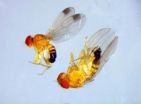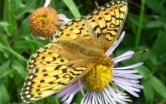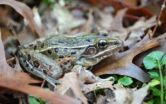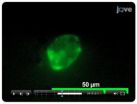(Press-News.org) Coming from the Asian continent, Drosophila suzukii has only been in Spain for a short time. Far away from slipping through into the Iberian Peninsula, it accelerated towards the north of Europe where it has already crossed the Alps. Amongst its preferred target are cherries and red fruits but any type of fruit is suitable for it to lay its eggs. This insect is posing a threat to the fruit of more and more European countries.
"Out of the 3,000 known species of Drosophilae, commonly named the vinegar fly, only two are potentially dangerous to fruit crops. One of them is Drosophila suzukii," assures Gemma Calabria, researcher at the Department of Genetics of the University of Barcelona (Spain).
The fly was accidentally discovered in the autumn of 2008 in Rasquera (Tarragona) and has actively or passively spread at a rate of 1,400 km per year via affected fruit transported by humans. The Drosophila has also reached Barcelona, where it was not found when first detected in Spain.
According to the study conducted by Calabria and her team, which has been published in the Journal of Applied Entomology, various regions of France and Italy have come under attack since 2009. As Calabria states, "Drosophila suzukii was discovered in the USA at the same time it was detected in Spain and it spread along the entire West coast, from California until reaching Canada. It has even been found on the East Coast, in Florida."
From the researchers' point of view, the colonisation towards the north of Europe and the American continent suggests that this species does not "especially" require a dry Mediterranean climate. "But if it spreads to more humid regions, it could cause a major agricultural epidemic," demonstrate the authors of the study.
VIDEO:
Coming from the Asian continent, Drosophila suzukii has only been in Spain for a short time. Far away from slipping through into the Iberian Peninsula, it accelerated towards the north...
Click here for more information.
A possible plague
Native to Asia, Drosophila suzukii was found for the first time in Japan and it is mainly characterised by the fact that the females lay their eggs in unaffected fruit. Calabria points out that "they have a large, serrated ovipositor organ that is capable of penetrating the skin of the fruit. As a result, their larvae grow inside thus destroying the fruit."
The researchers outline that since its discovery, damages to cherries and other types of berries have been reported in those countries affected. Although its favourite hosts seems to be the cherry, when it is out of season, the flies move on to other fruits.
Drosophila suzukii has caused significant damages to cherry and strawberry crops in the USA but went unnoticed in Spain for the first few years. However, it appears that in 2011 there were "major damages to different fruits" according to Institute of Agro-Food Research and Technology in Spain.
Research into the fly has allowed it to be placed on the list for phytosanitary prevention in many regions and countries throughout Europe. One of the best way to fight against the plague of flies is the use of fly traps. They allow for early detection and confirm whether the population is in growth.
The researchers advise that low quality fruit should be thrown out and infected pieces should be stored at temperatures lower than 3 to kill the eggs and larvae. This, in turn, will not compromise the quality of the fruit.
INFORMATION:
References:
Calabria, G.; Maca, J.; Bachli, G.; Serra, L.; Pascual, M. "First records of the potential pest species Drosophila suzukii (Diptera: Drosophilidae) in Europe" Journal of Applied Entomology 136(1-2): 139-147 DOI: 10.1111/j.1439-0418.2010.01583.x February 2012.
An invasive Asian fly is taking over European fruit
The study has been published in the Journal of Applied Entomology
2012-03-19
ELSE PRESS RELEASES FROM THIS DATE:
Survival of the fittest -- ESF hosts session on the challenges of life in extreme environments
2012-03-19
Have you ever wondered how life is sustained in environments like deserts, deep seas or the polar regions? How do organisms adapt and thrive in such harsh conditions, and what challenges do they face as a result of human activities and climate change, especially climate "extremization"? Shedding light on some of these issues is the objective of the European Science Foundation's (ESF) session on 27 March at Planet Under Pressure 2012. The session will look at different aspects of life in extreme environments - from knowledge to sustainable exploitation of new resources under ...
Treating psoriasis to prevent heart attacks and strokes
2012-03-19
Montreal, March 16, 2012 – A clinical study co-led by the Montreal Heart Institute and Innovaderm Research Inc., which was presented today at the annual meeting of the American Academy of Dermatology, shows that a new treatment for psoriasis could be associated with a significant decrease in vascular inflammation, a major risk factor of cardiovascular disease.
Psoriasis is a chronic inflammatory disease of the skin and joints that affects up to 3% of the population. This disease is associated with a greater risk of heart attack (infarction) and stroke. The goal of this ...
Early spring drives butterfly population declines
2012-03-19
Early snowmelt caused by climate change in the Colorado Rocky Mountains snowballs into two chains of events: a decrease in the number of flowers, which, in turn, decreases available nectar. The result is decline in a population of the Mormon Fritillary butterfly, Speyeria mormonia.
Using long-term data on date of snowmelt, butterfly population sizes and flower numbers at the Rocky Mountain Biological Laboratory, Carol Boggs, a biologist at Stanford University, and colleagues uncovered multiple effects of early snowmelt on the growth rate of an insect population.
"Predicting ...
Hiding in plain sight, new frog species found in New York City
2012-03-19
In the wilds of New York City--or as wild as you can get that close to skyscrapers--scientists have found a new leopard frog species.
For years, biologists mistook it for a more widespread variety of leopard frog.
While biologists regularly discover new species in remote rainforests, finding this one in ponds and marshes--sometimes within view of the Statue of Liberty--is a big surprise, said scientists from the University of California, Los Angeles; Rutgers University; the University of California, Davis and the University of Alabama.
"For a new species to go unrecognized ...
Checking off symptoms online affects our perceptions of risk
2012-03-19
You've been feeling under the weather. You Google your symptoms. A half-hour later, you're convinced it's nothing serious—or afraid you have cancer. More than 60 percent of Americans get their health information online, and a majority of those decide whether to see a doctor based on what they find. "Wow, this is an era of self-diagnosis," thought Arizona State University psychologist Virginia Kwan, learning that statistic. How might information accessed online affect individual health decisions?
In a new study, Kwan and her colleagues found that the way information is ...
Researchers uncover molecular pathway through which common yeast becomes fungal pathogen
2012-03-19
TORONTO, ON—Scientists at the University of Toronto have found a molecular mechanism that plays a key role in the transition of Candida albicans yeast into disease-causing fungus—one of the leading causes of hospital-acquired infection. The finding highlights the importance of heat in fungal growth, and provides a new target for drug therapies to counter Candida albicans infection.
Candida albicans is a normally harmless yeast that is present in all humans. It becomes infectious in various genetic and environmental conditions, with temperature as a key determinant. It ...
Increase in Arctic shipping poses risk to marine mammals
2012-03-19
NEW YORK (March 16, 2012)—A rapid increase in shipping in the formerly ice-choked waterways of the Arctic poses a significant increase in risk to the region's marine mammals and the local communities that rely on them for food security and cultural identity, according to an Alaska Native groups and the Wildlife Conservation Society who convened at a recent workshop.
The workshop—which ran from March 12-14—examined the potential impacts to the region's wildlife and highlighted priorities for future management of shipping in the region. The meeting included participants ...
Glacier-fed river systems threatened by climate change
2012-03-19
Glacial meltwater increases biodiversity in mountainous freshwater ecosystems. As glaciers vanish due to global warming, so will those species dependent upon the icy runoff. This is the conclusion of a study authored by researchers from, among other institutions, the University of Copenhagen.
The article "Glacial river biodiversity" with the alarming new findings can be found in the journal Nature Climate Change.
"The knowledge is new and startling. Glacial runoff is cold, nutrient-poor and physically unstable, and therefore, typically species-poor. Traditionally, we ...
Researchers print live cells with a standard inkjet printer
2012-03-19
Researchers from Clemson University have found a way to create temporary holes in the membranes of live cells using a standard inkjet printer. The method will be published in JoVE, the Journal of Visualized Experiments, on March 16.
"We first had the idea for this method when we wanted to be able to visualize changes in the cytoskeleton arrangement due to applied forces on cells," said paper-author Dr. Delphine Dean.
She said other researchers have been using this method to print cells onto slides, but that they have only recently discovered that printing the cells ...
Study determines critical skills for PCPs to safely manage opioid risk in chronic pain patients
2012-03-19
The study's objective was to identify which skills and competencies are considered most critical for primary care providers (PCPs) to learn in order to effectively manage opioid risk in patients treated for chronic pain
Study participants included experts in primary care, pain management, and addiction
Experts in this study identified the most important skills for PCPs managing opioid risk in chronic pain patients as how to monitor opioids and how to assess for risk factors
Primary care physicians are faced with treating a large proportion of chronic pain patients, ...
LAST 30 PRESS RELEASES:
Tracing the quick synthesis of an industrially important catalyst
New software sheds light on cancer’s hidden genetic networks
UT Health San Antonio awarded $3 million in CPRIT grants to bolster cancer research and prevention efforts in South Texas
Third symposium spotlights global challenge of new contaminants in China’s fight against pollution
From straw to soil harmony: International team reveals how biochar supercharges carbon-smart farming
Myeloma: How AI is redrawing the map of cancer care
Manhattan E. Charurat, Ph.D., MHS invested as the Homer and Martha Gudelsky Distinguished Professor in Medicine at the University of Maryland School of Medicine
Insilico Medicine’s Pharma.AI Q4 Winter Launch Recap: Revolutionizing drug discovery with cutting-edge AI innovations, accelerating the path to pharmaceutical superintelligence
Nanoplastics have diet-dependent impacts on digestive system health
Brain neuron death occurs throughout life and increases with age, a natural human protein drug may halt neuron death in Alzheimer’s disease
SPIE and CLP announce the recipients of the 2025 Advanced Photonics Young Innovator Award
Lessons from the Caldor Fire’s Christmas Valley ‘Miracle’
Ant societies rose by trading individual protection for collective power
Research reveals how ancient viral DNA shapes early embryonic development
A molecular gatekeeper that controls protein synthesis
New ‘cloaking device’ concept to shield sensitive tech from magnetic fields
Researchers show impact of mountain building and climate change on alpine biodiversity
Study models the transition from Neanderthals to modern humans in Europe
University of Phoenix College of Doctoral Studies releases white paper on AI-driven skilling to reduce burnout and restore worker autonomy
AIs fail at the game of visual “telephone”
The levers for a sustainable food system
Potential changes in US homelessness by ending federal support for housing first programs
Vulnerability of large language models to prompt injection when providing medical advice
Researchers develop new system for high-energy-density, long-life, multi-electron transfer bromine-based flow batteries
Ending federal support for housing first programs could increase U.S. homelessness by 5% in one year, new JAMA study finds
New research uncovers molecular ‘safety switch’ shielding cancers from immune attack
Bacteria resisting viral infection can still sink carbon to ocean floor
Younger biological age may increase depression risk in older women during COVID-19
Bharat Innovates 2026 National Basecamp Showcases India’s Most Promising Deep-Tech Ventures
Here’s what determines whether your income level rises or falls
[Press-News.org] An invasive Asian fly is taking over European fruitThe study has been published in the Journal of Applied Entomology




